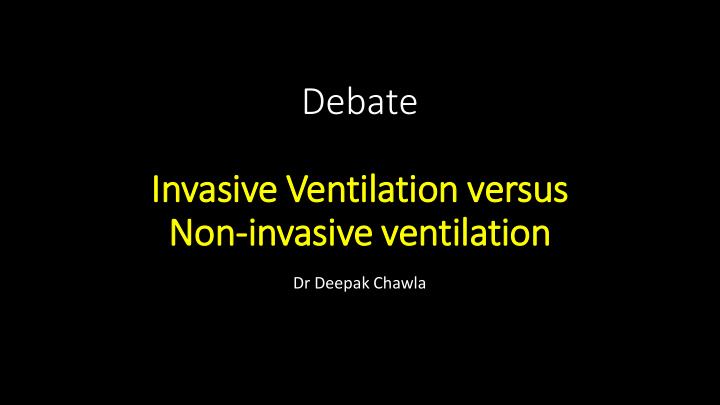



Debate In Invasive Ventilation versus Non-invasive ventilation Dr Deepak Chawla
For r In Invasive Ven entil ilation Dr Deepak Chawla
Argument 1: You can not es�ape the �Tu�e�
Exhibit 1.1: Hidden truth behind trials! Study Outcome Survival without need of ventilation at D7 SUPPORT Days of ventilation COIN Need of ventilation Need of ventilation VON Days of ventilation
Exhibit 1.1: Hidden truth behind trials! Study Outcome NIV group IV group Survival without need of 55.3% 48.8% ventilation at D7 SUPPORT Days of ventilation 24.8 27.7 COIN Need of ventilation 59% 100% (by design) Need of ventilation 52.3-59.3% 95.7% VON Days of ventilation 9.2 to 12.5 7.7
Exhibit 1.2: Morbidities for which IV is needed 2000 • Meconium aspiration syndrome 1900 1800 • Birth asphyxia with poor respiratory 1700 drive 1600 1500 • Persistent pulmonary hypertension of 1400 1300 newborn 1200 1100 • Prolonged/repeated apnea of 1000 prematurity RDS MAS • Surgical neonates NNPD 2002-2003, n=145623
Argument 2: For NIV to work you need steroids!
Exhibit 2.1: Effect of ANS Need of respiratory support RR: 0.69 (0.53-0.90) 32.50% 21.70% ANS No ANS Roberts & Dalziel Cochrane 2010 Moise et al Pediatrics 1995;95:845
Exhibit 2.2: NIV trial and steroids 100% 90% 80% 70% 60% Antenatal steroid coverage in India: 20-40% 50% 40% 30% 20% 10% 0% ANS use SUPPORT COIN VON
Exhibit 2.3: NIV trial and steroids Outcome Intervention Control RR (95% CI) (n=48698) (n=52007) Neonatal deaths <7 days 21.9/1000 19.1/1000 1·12 (1·02 – 1·22) Neonatal deaths <28 days 27.4/1000 23.9/1000 1·12 (1·02 – 1·22) Suspected maternal infection 3% 2% 1.45 (1.33-1.58)
Argument 3: Each has its own set of complications!
Exhibit 3.1: Complications Invasive Non-invasive
Exhibit 3.2: Complications Invasive Non-invasive • Bronchopulmonary dysplasia • Failure of CPAP • Pneumonia • Pneumonia • Laryngeal injury • Nasal injury • Tube block/displacement • CPAP belly • Decreased venous return
Argument 4: NIV is not less but more intensive!
Exhibit 4.1: More intensive monitoring • Securing and maintaining proper fixation • Monitor for CPAP failure • 25-40% may fail • Monitor for side effects • CPAP belly • Nasal trauma • Infection
Evidence from India Author (Year) Study subjects Design and intervention Result Tagare et al Preterm neonates with respiratory RCT Higher success rate with B- (2013) distress within first 6 h of life Bubble-CPAP versus ventilator CPAP (82.5% vs. 63.2%) CPAP Saxena et al Preterm neonates with RDS Observational Overall 88% survival (2012) Early CPAP and selective surfactant CPAP successful in 61% Yadav et al Preterm neonates post-extubation RCT Trend towards reduced (2012) Bubble-CPAP versus ventilator extubation failure in BCPAP CPAP Pillai et al Preterm neonates with RDS Observational Predictors of CPAP failure: (2011) Early CPAP Gest<28, PPROM and Pressure X FiO2>1.28
Evidence from India Author (Year) Study subjects Design and intervention Result Tagare et al Preterm neonates with respiratory RCT Comparable success rate (2010) distress within first 6 h of life Bubble-CPAP versus ventilator CPAP Koti et al Preterm neonates with RDS Observational CPAP successful in 75% (2010) Bubble CPAP Kishhore et al Preterm neonates with RDS RCT Higher success rate of NIPPV (2009) CPAP versus NIPPV Urs et al Preterm neonates with RDS Observational Successful in mild to moderate (2009) Early B-CPAP RDS and in neonates with ANS coverage
Argument 5: You can not synchronize nasal ventilation!
Exhibit 5.1: Synchronization is needed Pediatric Research (2011) 69 , 84 – 89
Exhibit 5.2: No true synchronization for NIPPV
Summary 1. Many babies will still need invasive ventilation 2. Without antenatal steroids NIV more likely to fail 3. Non-invasive ventilation can also cause complications 4. Non-invasive ventilation is not less intensive 5. Synchronization possible only with invasive ventilation
Recommend
More recommend